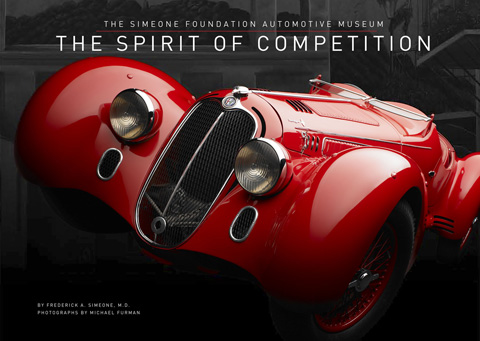
The Simeone Foundation Museum
The Spirit of Competition
By Frederick A. Simeone, MD.
Preface by Mario Andretti
Photograph by Michael Furman
Coachbuilt Press, 2009, $185
Hardbound, 13 x 9.5 inches
Copies can be ordered from www.simeonemuseum.org
“The Spirit of Competition” will make its official debut to the public at The Quail on August 14th. Coachbuilt Press will have copies for sale in their booth there as well as at Pebble Beach on Sunday.
Book Review by Pete Vack
“The Spirit of Competition” was published as a guide to the 65-odd classic cars (including 13 Italian and four French) of the Simeone Foundation. Hardbound with 384 pages, photography by Michael Furman and a price of $185, it is arguably more complex, more controversial, more colorful and comprehensive than any other such publication serving an automotive foundation or museum.
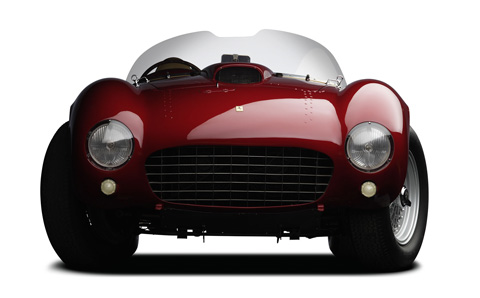
Ferrari 375 MM, S/N 0412 AM. All photos by Michael Furman from the book “The Spirit of Competition”.
Author, collector, neurosurgeon and now executive director of the Simeone Foundation, Fred Simeone would have had it no other way. “The Spirit of Competition” is a testament to his vision and viewpoints, some of which, as he admits, are not always popular. In the introduction to this massive and beautiful work, Simeone clearly relates and justifies his core convictions, laying out the reasons why the cars of the Foundation are often unrestored, or merely refurbished, and why, save one, they all have lights and mudguards. (The Foundation’s focus is on sportscars, not open wheel race cars).
Simeone asks, “Will automobiles ever achieve the historical legitimacy of other important objects?” As objects of art, historical icons and meaningful artifacts, automobiles are still not taken seriously in the wider world of collecting, despite the high market prices. An antique furniture collector himself, Simeone compares the valuation of antique furniture to that of classic cars and points out that any later modifications, improvements, or replacements to an original 19th century Pennsylvania Chippendale chest would debase its value–why, he asks, doesn’t the same apply to a Bugatti? While the unrestored movement is gaining in strength among the car community, it has a long way to go.
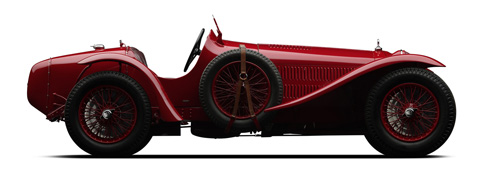
1933 Alfa Romeo Monza, S/N 2211112
The Simeone ideal is to buy cars without a great deal of “drama”. which are in an “as found” or “as raced last” condition. The goal, while truly worthy, is not always easy to achieve without criticism. When writing the story of the Simeone Foundation for Automobile Quarterly, (See “Time and Two Seats, Distilled,” AQ V48 N. 3) your editor witnessed firsthand the still-ongoing argument between the creator of the Cobra Daytona Coupe, Pete Brock, and Simeone. After having obtained the long lost prototype Cobra coupe, (and one of the greatest barn-find stories ever) Simeone set out to refurbish (not restore) it to the condition it was in at its last competitive appearance–on the Bonneville Salt Flats and basically, “as found” when purchased by Simeone. Brock, on the other hand, wanted the car to be restored to the pristine condition it was when it left the factory. Both had valid points, but Simeone’s view prevailed, of course, and the first Daytona Coupe appears today much like it did when in November of 1965, Craig Breedlove broke more than 23 class records on the salt. After listening carefully to both parties, it was clear to us that an agreement would never be reached on the subject.
Fred’s desire not to over-restore and to keep cars in relatively original condition is, in our opinion, the right way to go. One of our favorite cars is the 1929 ex-Sam Bird Alfa 1750 SS, almost rough looking, in the chipped yellow livery it had when raced by Hastings Foote in the mid 1930s. Another Alfa, an 8C2300 once owned by cartoonist Charles Addams, remains virtually untouched, its ragged red body a product of the great coachbuilder Castagna. It exudes charm beyond comprehension; therein lies one of the great assets of the Simeone Foundation.
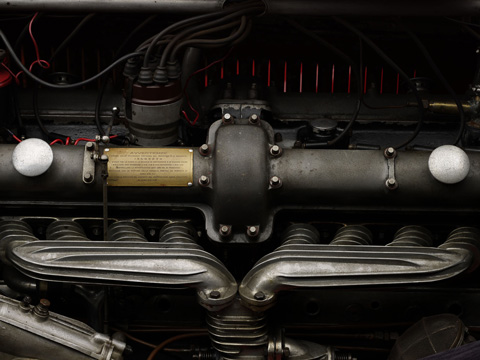
Alfa Romeo 8C 2300 Castagna.
For those who have visited the Foundation, the layout of the book is understandable. For those who haven’t, it might take a bit of getting acquainted, for Simeone has a rather unique way of organizing the subjects. It is not chronological alone, but shaped by the collection itself (here’s what I have bought, now let’s see how to best present the cars) and the geography of racing, accented by the enormous dioramas of the Foundation. Hence the first chapter, “American Road Racing before WWI” reminds us that before the Great War races like the Vanderbilt Cup put American cars on an even keel with their European counterparts. Into this category are wonderful cars like the American Underslung and the Mercer Raceabout. Then a gap of about 15 years and “American Road Racing Resumes” covers the years from 1935 to the mid 1950s with a presentation of ten cars. This is followed by “Road Racing in England,” “Road Racing in Italy,” etc. In general, the book layout follows the museum’s physical layout and structure; cars within the chapters are not necessary in chronological order.
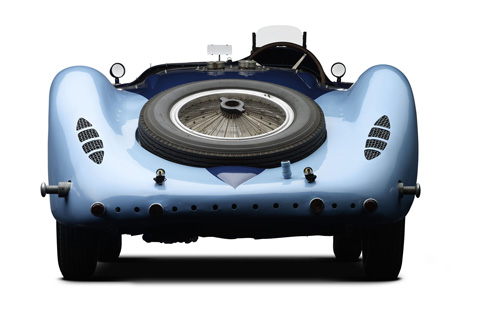
1936 Bugatti T57 “Tank”
Within each category is a full description of every car, illustrated not only with Furman’s excellent photography, but with historical photos, posters, and anecdotal material. First is a brief overview of the car and manufacturer, then details of the acquisition and condition of the particular car (with serial numbers), and finally, a section on what is was like to drive the car. In most cases, Simeone used contemporary driving reports and road tests.
Which brings to the fore another often controversial aspect of the Simeone collection—while concentrating on the spirit of competition (the book’s peface is written by Mario Andretti defining the phrase), Simeone does not believe in vintage racing his cars. He has brought the 1938 Mille Miglia winning 8C2900 to the retro Mille Miglia, but that is a rally, not a race. You won’t see his cars at Lime Rock or Monterey. Most consider this very unfortunate. Simeone considers this essential to maintaining the cars in relatively original condition. And after all, no one complains when the Smithsonian refuses to put their collection of war birds up in the air every month. To offset this, the Simeone Foundation has a huge parking lot behind the building which is used to exercise the thoroughbreds in the collection. Needless to say, Simeone has thoroughly discussed his position in the introduction.
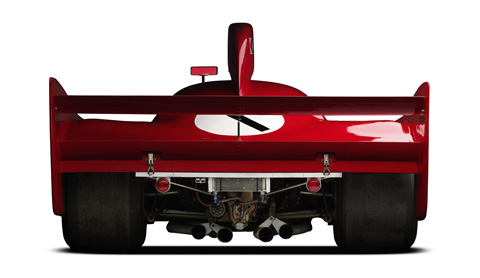
1975 Alfa Romeo Tipo 33
Fred Simeone, working closely with Michael Furman and his staff, has produced a volume that offers a informative, unique inside look at each one of the classics in the museum, while at the same time, providing a clearly stated philosophical framework for the next executive director of the Simeone Foundation, as well as collectors who share his thoughts about the importance of originality.
If you have been to the Foundation, you will want to have a copy of this book.
If you’ve never been, you could buy the book and by doing so take a look at this very unique and important collection. Either way, it’s worth it.
Wow! Unrestored! Wunnerful wunnerful wunnerful! A few years ago on the Mille in Sandy Orttewell’s ’28 Alfa 1500S, Sig. Bellabarba (one of Simon Moore’s research associates) ran up to us at the first lunch stop and his first words were “Thank heavens! We thought it might have been restored!” The Alfa still has traces of a number painted on the fabric body sometime in the ’30s; it looks GREAT.